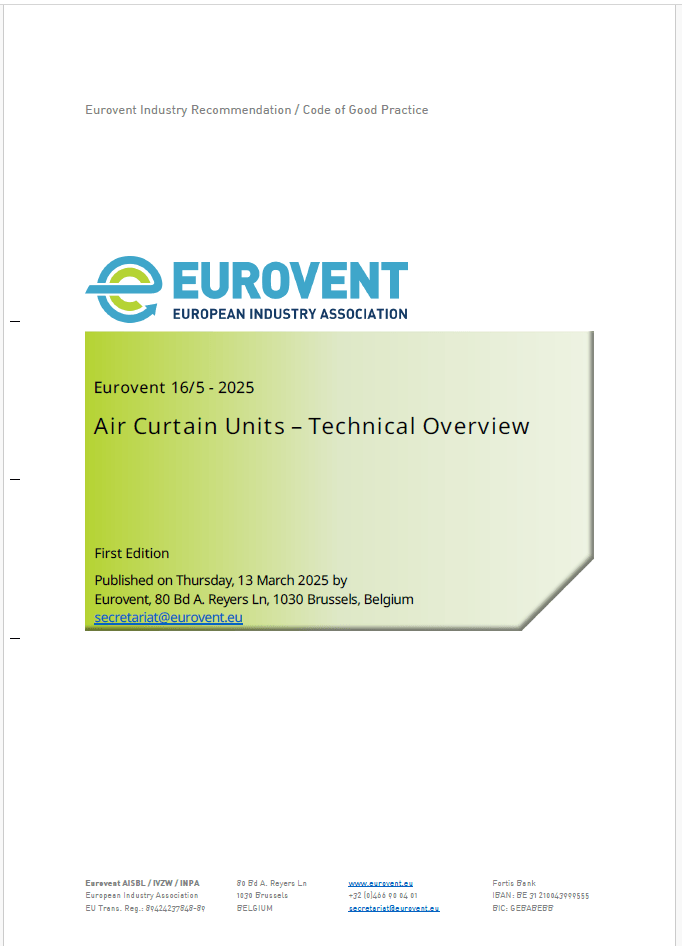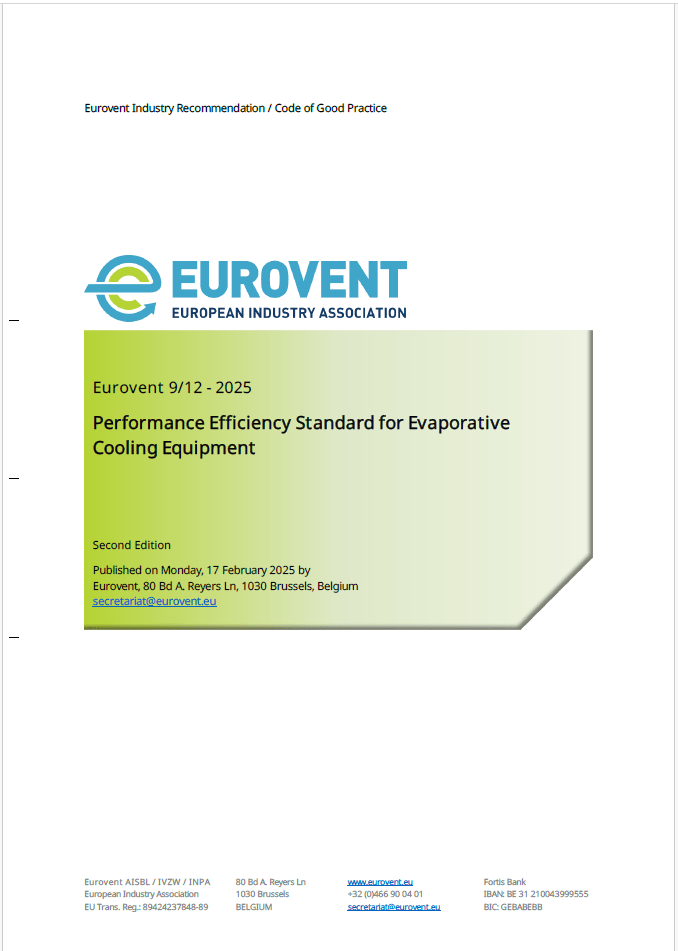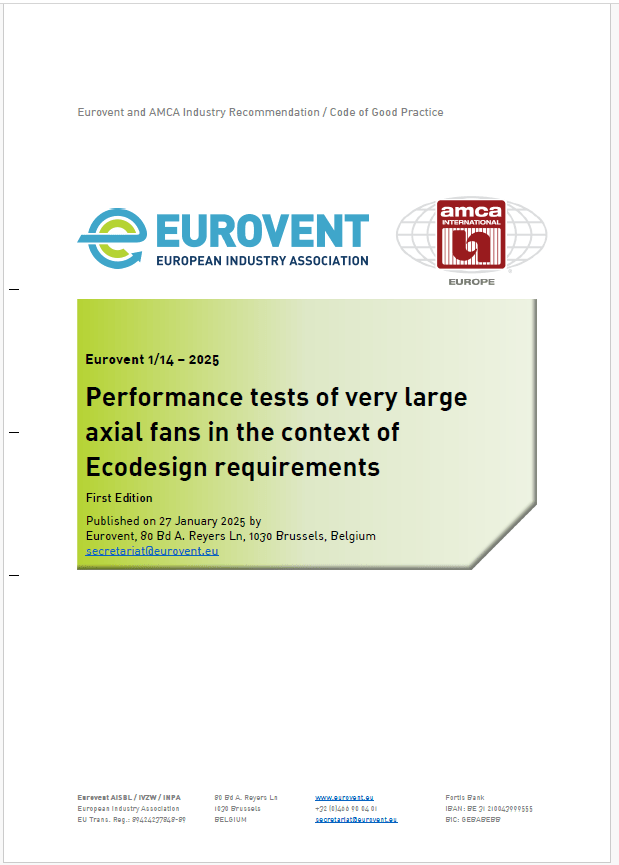In view of the projected growth of ventilation solutions as a result of COVIDeurovent-market-intelligence/news/eurovent-market-intelligence/-19, Eurovent Middle East looks at the importance of implementing a regulatory framework to ensure solutions and practices in the region lead to better indoor air quality (IAQ) that will protect building inhabitants in the years to come.

 As the growing importance of indoor air quality (IAQ) following COVIDeurovent-market-intelligence/news/eurovent-market-intelligence/-19 drives greater demand for ventilation solutions, there is also an urgent need to develop a corresponding regulatory framework that will ensure design, installation and maintenance practices truly reflect the best interest of the building inhabitants. Such a move is long overdue, says William P. Bahnfleth, Professor of Architectural Engineering, The Pennsylvania State University. “The pandemic has created broad awareness of the critical importance of indoor air quality, which some – including myself – have been preaching about for decades,” he says. “The consequences of poor ventilation and filtration are now impacting the everyday lives of virtually everyone in the world, creating immense human and economic damage. One must hope that this experience will lead to significant changes in the way we view IAQ, with corresponding changes to minimum standards and best practices.”
As the growing importance of indoor air quality (IAQ) following COVIDeurovent-market-intelligence/news/eurovent-market-intelligence/-19 drives greater demand for ventilation solutions, there is also an urgent need to develop a corresponding regulatory framework that will ensure design, installation and maintenance practices truly reflect the best interest of the building inhabitants. Such a move is long overdue, says William P. Bahnfleth, Professor of Architectural Engineering, The Pennsylvania State University. “The pandemic has created broad awareness of the critical importance of indoor air quality, which some – including myself – have been preaching about for decades,” he says. “The consequences of poor ventilation and filtration are now impacting the everyday lives of virtually everyone in the world, creating immense human and economic damage. One must hope that this experience will lead to significant changes in the way we view IAQ, with corresponding changes to minimum standards and best practices.”
Bahnfleth says that he thinks infection control, which currently is a priority only in hospitals and related facilities, will be addressed in air quality standards for all buildings, which could lead to increasing ventilation and filtration requirements. “Because some air quality improvements have the potential to increase energy use, I believe that there will be changes to operations targeting better IAQ with reduced energy use, for example, advanced temporal and spatial demand control that will both raise IAQ and reduce energy use,” he says.

 Igor Sikonczyk, Senior Technical and Regulatory Affairs Manager, Eurovent Association, believes that concerns related to COVIDeurovent-market-intelligence/news/eurovent-market-intelligence/-19 is also a driving force behind the move to implementing requirements concerning air quality at the European Union (EU) level. “The European standardisation committee initiated and launched a discussion on whether there is a need to do something in all standards related to ventilation,” he says. “This should also address COVID for future design guidelines, because we have to be prepared down the road. The new standards should be able to face such problems in the future. Hopefully, the pandemic can spark a discussion on some concrete requirements for IAQ in Europe and, I believe, across the world.”
Igor Sikonczyk, Senior Technical and Regulatory Affairs Manager, Eurovent Association, believes that concerns related to COVIDeurovent-market-intelligence/news/eurovent-market-intelligence/-19 is also a driving force behind the move to implementing requirements concerning air quality at the European Union (EU) level. “The European standardisation committee initiated and launched a discussion on whether there is a need to do something in all standards related to ventilation,” he says. “This should also address COVID for future design guidelines, because we have to be prepared down the road. The new standards should be able to face such problems in the future. Hopefully, the pandemic can spark a discussion on some concrete requirements for IAQ in Europe and, I believe, across the world.”
Further highlighting the need for regulation in this area, Bahnfleth also points out that a recent study found that over 40% of the roughly 100,000 schools in the US had heating, ventilation, and air-conditioning systems in need of significant repairs. “In the US, we must have our vehicles inspected every year and cannot drive them legally until they meet state standards, yet there are no such requirements for the buildings in which we spend nearly 90% of our time and which are responsible for about 40% of primary energy use,” he says. “Energy certification of buildings is a developing trend. I think that performance requirements should also address IAQ, which affects the most costly part of a building – those who inhabit it.”

 Tariq Al Ghussein, CEO, Taqeef, shares a similar opinion: “Like any framework, regulatory guidelines need to evolve with societal trends, and COVIDeurovent-market-intelligence/news/eurovent-market-intelligence/-19 will have shone a spotlight on this area for sure,” he says. “In my view it’s likely, that after a period of reliable study, current guidelines might well be adapted. As a business, we follow REHVA and the current ISO 16890 and EN 1822 protocols in all we do, while looking to other industry leaders for examples of best practice that we can emulate. As an association it’s about sharing our learnings and supporting each other to constantly strive for better.”
Tariq Al Ghussein, CEO, Taqeef, shares a similar opinion: “Like any framework, regulatory guidelines need to evolve with societal trends, and COVIDeurovent-market-intelligence/news/eurovent-market-intelligence/-19 will have shone a spotlight on this area for sure,” he says. “In my view it’s likely, that after a period of reliable study, current guidelines might well be adapted. As a business, we follow REHVA and the current ISO 16890 and EN 1822 protocols in all we do, while looking to other industry leaders for examples of best practice that we can emulate. As an association it’s about sharing our learnings and supporting each other to constantly strive for better.”
This is especially true for the Middle East, says Bahnfleth. He points out that in the region, like in other parts of the world, an overzealous focus on energy and environment often leads to the acceptance of marginal standards for indoor environmental quality. “If the countries of the Middle East would simply adopt indoor air quality standards of stringency equal to those adopted in North America and Europe, that would be a good start,” he says. “Kuwait has been especially proactive in pursuing the development of appropriate standards for both energy and indoor air quality.”

 Weighing in, Dr. Iyad Al Attar, Independent Air Filtration Consultant, says that in the past, implementation of existing standards was very lean and filter acquisition has been always price-driven. “We regard air filters as expensive items and we conduct meetings to fiercely obtain substantial discounts for filter acquisition,” he says. “Our minds cease to grant air filter the “value” it deserves. We miscalculate the cost by equating price to value, and overlook intellectual properties, technological expertise, research and development investments. By doing so, we reinforce the view that filter testing, quality and performance are peripheral to the selection criteria. We, thus, bluntly declare that such critical factors are on the wrong side of our balance sheet.” He stresses that there is a huge gap between rhetoric and actions when it comes to appropriate filter selection, installation, and performance. “The new ISO16890 test method correctly places emphasis on filtration performance related to particulate matter sizes, hence, providing a more practical test criteria than the outdated EN779:2012,” he says. “However, we need to realise that physical and chemical characterisation of outdoor air pollutants is essential to making appropriate air filter selection.”
Weighing in, Dr. Iyad Al Attar, Independent Air Filtration Consultant, says that in the past, implementation of existing standards was very lean and filter acquisition has been always price-driven. “We regard air filters as expensive items and we conduct meetings to fiercely obtain substantial discounts for filter acquisition,” he says. “Our minds cease to grant air filter the “value” it deserves. We miscalculate the cost by equating price to value, and overlook intellectual properties, technological expertise, research and development investments. By doing so, we reinforce the view that filter testing, quality and performance are peripheral to the selection criteria. We, thus, bluntly declare that such critical factors are on the wrong side of our balance sheet.” He stresses that there is a huge gap between rhetoric and actions when it comes to appropriate filter selection, installation, and performance. “The new ISO16890 test method correctly places emphasis on filtration performance related to particulate matter sizes, hence, providing a more practical test criteria than the outdated EN779:2012,” he says. “However, we need to realise that physical and chemical characterisation of outdoor air pollutants is essential to making appropriate air filter selection.”
Sikonczyk says setting minimum standards and promoting regulation would also help move the industry away from cost-centric thinking. “It’s clear that developers want to cut cost at the lowest possible level,” he says. “The best incentive is a regulation or obligatory minimum requirements. Incentives to drive this renovation wave should come from the government but the other driving force can come directly from market. The awareness of people on the impact of indoor air quality on pandemic transmission and the effort to contain pandemic development is important. People that are in buildings should know the importance of good IAQ and they should expect more from the developer and building owners. They should ask, ‘What you are offering here? Is the environment you are selling safe or not?’. This would force owners of buildings towards renovation. This would be our role as the industry or Association — to make people aware and promote some good practices and good technologies.”
For Dr. Al Attar, continuous aerosol monitoring can be a game changer as far as the number and type of air filtration technology being installed. “We ought to employ our characterisation tools to reveal what our lungs inhale and our eyes fail to trace,” he says. “Once revealed what was forever concealed, I am certain that there is no price we will not pay to attain the air quality needed for each specific application.”
Dr. Al Attar adds that another challenge related to standards is their suitability to Middle Eastern climate conditions as far as sandstorms, excessive moisture and heat are concerned. “In the Sahara Desert, such as the Arabian Peninsula, sandstorms increase the particle concentration in the air and affect the dust loading of the air filters in the air handing units,” he says. Considering filtration is location and application sensitive, special considerations should be granted to the climate conditions, since they pose additional challenges to the filtration performance, he adds. “In fact, research has proven that such conditions can contribute to the deviation of filter performance of that predicted by global testing laboratories,” he says. “Various atmospheric pollutants can easily invade our indoor space using HVAC systems as a vehicle if left untreated. Since an adult typically breathes an average of 10 litres of air per minute, even a low concentration of airborne contaminants represents a large quantity of inhaled particles and can pose health hazards.”
Bahnfleth says that while most think of resilience as protecting the building from hazards like earthquakes and hurricanes, an important essential change he hopes to see is for the concept of resilience to include protection of building occupants, and for this to be widely accepted and incorporated in design standards and operating procedures.




















